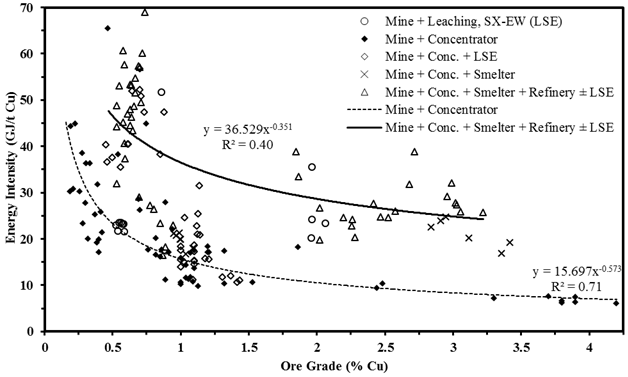Abstract
The energy, greenhouse gas (GHG) emissions and water intensity, or environmental footprints, of global primary copper production have been estimated. The primary data have been collected from the sustainability reports published by copper producing mines, operations and companies. The mines analysed in this paper are from Australia, Chile, Peru, Argentina, Laos, Papua New Guniea, South Africa, Turkey, Finland, the USA and Canada. The typical range of energy intensity was found to be 10e70 GJ/t Cu, with an average of 22.2 GJ/t Cu. The range of GHG emissions was 1e9 t CO2-e/t Cu, with an average of 2.6 t CO2-e/t Cu. The large variation exists largely due to the form of copper produced, ore grade, sources of fuel and electrical energy, and to a lesser extent the reporting methods and procedures used by the companies. The water footprint averages 70.4 kL/t Cu but can range from several kilolitres to up to 350 kL/t Cu. Variation in water intensity is generally due to inconsistencies in reporting method, the geographical location of the mining operations, limited economies of scale of production site, and the climate type (i.e. arid regions in Australia and Chile or temperate to subarctic climates in Canada or Finland). It is recommended that company sustainability reports should clearly specify fuel use by type for vehicles, heat or electrical energy, sources of electricity and their mixes (including GHG emissions factors), and the boundaries of the operation for meaningful use in life cycle assessment (LCA). Sustainability reports should be published at regular intervals so that improvements towards more sustainable performance can be measured, and an LCA of mining activities can be developed for primary copper production more readily. The paper provides a valuable insight into the strong value of sustainability reporting for an industrial sector such as copper mining and how such data can be linked to LCA studies.
